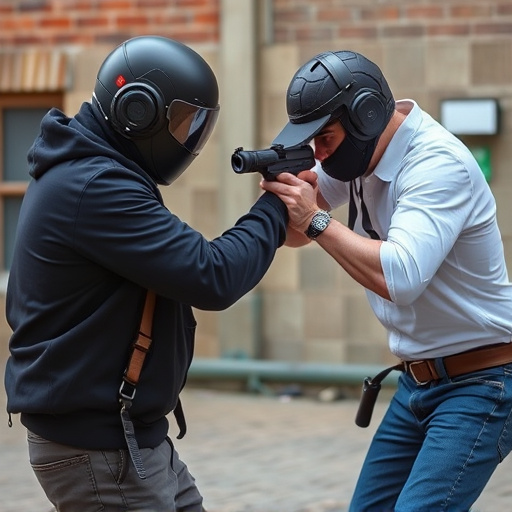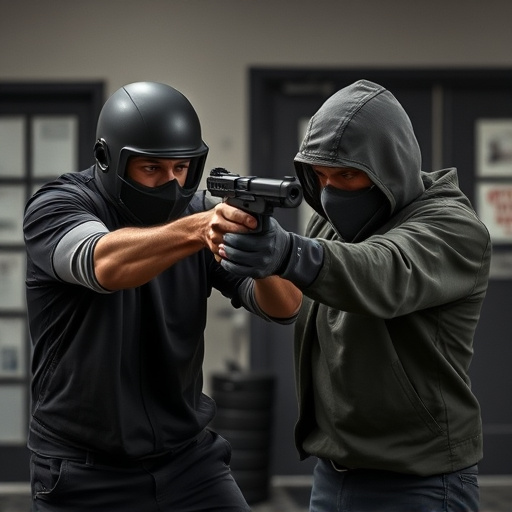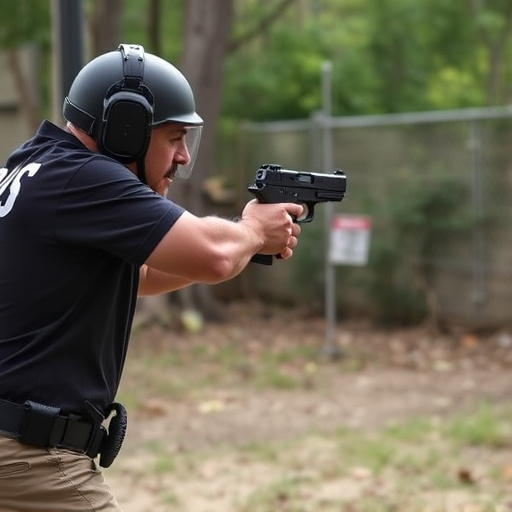When choosing a best stun gun for home defense, focus on electrode spacing (1-2 inches) for balanced current flow and area coverage. Consider voltage output adjustability for effectiveness and minimizing harm. Optimal electrode placement ensures powerful shocks without excess damage, with a recommended distance of 2-3 inches between them. Prioritize safety: understand laws, store securely, inspect regularly, and practice responsible deployment techniques. Real-world testing shows optimal spacing for maximum shock is 2-3 inches, ensuring safe incapacitation.
“Uncover the secrets behind stun gun effectiveness, specifically focusing on electrode spacing and its impact. This comprehensive guide explores how proper spacing enhances stun guns’ power, ensuring maximum stun and home defense capabilities. From understanding key factors to choosing the best stun gun, we delve into optimal electrode placement for profound results. Additionally, we discuss safety measures and real-world testing, providing insights on selecting the ideal stun gun for personal protection.”
- Understanding Stun Gun Electrode Spacing
- Key Factors in Stun Gun Effectiveness
- Choosing the Right Stun Gun for Home Defense
- Optimal Electrode Placement for Maximum Impact
- Safety Considerations: Using Stun Guns Responsibly
- Real-World Testing of Stun Gun Performance
Understanding Stun Gun Electrode Spacing

When considering the best stun gun for home defense, understanding electrode spacing is crucial. Electrode placement and spacing on a stun device directly impact its effectiveness by determining the current flow required to incapacitate a target. Closer electrode spacing generally allows for deeper penetration, increasing the chance of a successful shock. However, excessive proximity can lead to reduced surface area coverage, which might not be ideal for defensive scenarios where rapid de-escalation is key.
For home defense applications, stun guns with electrodes spaced optimally (typically between 1-2 inches apart) offer a balance between current intensity and wide area coverage. This spacing ensures that even if the device makes contact with an assailant’s arms or legs—common defensive positions—the electric current can still flow through to render them temporarily immobilized. Thus, choosing a stun gun with appropriate electrode spacing enhances its capability to serve as an effective home defense tool.
Key Factors in Stun Gun Effectiveness

The effectiveness of a stun gun largely depends on several key factors. One of the most critical aspects is the electrode spacing, which significantly influences the device’s ability to deliver a powerful shock. Stun guns with well-designed electrodes that maintain optimal spacing ensure precise and effective current flow, neutralizing threats swiftly. This is particularly important for home defense scenarios where the best stun gun for home defense should offer reliable performance without unnecessary harm.
Additionally, the voltage output plays a crucial role in stun gun effectiveness. Higher voltage levels can penetrate clothing and skin more efficiently, increasing the chances of incapacitation. However, it’s essential to strike a balance; excessive voltage may result in collateral damage or injuries. Therefore, users should opt for devices that offer adjustable voltage settings, allowing them to tailor the shock level according to their needs and local legal requirements.
Choosing the Right Stun Gun for Home Defense

When considering the best stun gun for home defense, electrode spacing plays a crucial role in ensuring its effectiveness. The optimal spacing between electrodes is around 1/4 inch (6 mm), allowing for maximum electrical conductivity and impact. This close proximity ensures that when the stun gun makes contact with an assailant, the electric current flows through their body, temporarily paralyzing them.
Choosing a stun gun with the right electrode configuration can make all the difference in self-defense scenarios. Opting for a model with precision-designed electrodes will provide more control and accuracy during use. Additionally, consider factors like weight, size, and ease of carry—a compact and lightweight design can be advantageous for quick retrieval and maneuverability within your home.
Optimal Electrode Placement for Maximum Impact

Optimal electrode placement is key to maximizing the effectiveness of a stun gun, especially when considering it as the best stun gun for home defense. For stun guns, the electrodes, or contact points, are designed to deliver an electric current to immobilize a target. Strategically placing these electrodes ensures a powerful and efficient shock. Typically, stun guns feature two main electrodes—a positive and a negative—that make contact with the attacker’s body. The ideal spacing between these electrodes is crucial; it allows for a balanced current distribution while minimizing the risk of accidental shocks to the user.
A best-practice guideline suggests maintaining a distance of around 2–3 inches (5–7 cm) between the electrodes. This spacing enables a comprehensive area of coverage without causing excessive damage or discomfort to the user. When the electrodes are too close, it may result in a concentrated shock that could potentially harm sensitive areas, while a wider gap might reduce the overall impact. For home defense, choosing a stun gun with adjustable electrode settings can offer greater control and customization for different scenarios, ensuring maximum effectiveness during an encounter.
Safety Considerations: Using Stun Guns Responsibly

When considering a best stun gun for home defense, safety should always be at the forefront of your mind. Responsible use involves understanding and adhering to key safety considerations. First and foremost, familiarize yourself with local laws regarding stun gun ownership and usage. Ensure you store your device securely, out of reach of children and unauthorized individuals. Regularly inspect your stun gun for any signs of damage or wear, replacing batteries promptly as needed.
Additionally, practice proper technique when deploying a stun gun. Aim for large muscle groups, such as the thighs or shoulders, to maximize impact while minimizing risk of severe injury. Never point the device at anyone unnecessarily, and only use it when absolutely necessary for self-defense. Remember, a stun gun is a powerful tool designed to incapacitate an attacker temporarily; its effectiveness lies in responsible, ethical usage.
Real-World Testing of Stun Gun Performance

In real-world scenarios, testing the effectiveness of stun guns involves more than just lab simulations. The performance of a stun gun is highly dependent on factors like electrode spacing and current distribution—aspects that can only be accurately assessed through practical trials. Studies have shown that the optimal electrode spacing for maximum shock effectiveness lies between 2 to 3 inches (5 to 7.6 cm). This range ensures a balanced delivery of electrical current, providing sufficient stun power while minimizing risk of user injury.
When looking for the best stun gun for home defense, considering these testing parameters is crucial. Many high-quality stun guns designed for personal protection feature electrode spacing within this optimal range, offering users a powerful yet controlled shock. Real-world testing also reveals that proper current distribution contributes to the stun gun’s ability to incapacitate an assailant without causing severe or permanent damage, making it a vital aspect in choosing self-defense equipment.
When selecting a stun gun for home defense, understanding electrode spacing and optimal placement is key to ensuring its effectiveness. By considering factors like body type and stun gun design, you can maximize impact. The best stun gun for home defense balances power with safety features, allowing responsible use while providing peace of mind. Real-world testing confirms that proper electrode spacing significantly enhances stun guns’ performance, making them valuable tools for personal protection.
